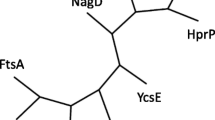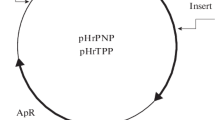Abstract
Segments of the human UMP synthase cDNA coding for the orotate phosphoribosyl transferase (OPRT) and orotidylate decarboxylase (ODC) domains of the bifunctional protein UMP synthase were produced by polymerase chain reaction techniques and cloned into a eukaryotic expression vector. The separate OPRT and ODC vectors, along with a selectable marker, were cotransfected into UMP synthase-deficient hamster cells (Urd−C) that require exogeneous uridine for growth. Transfected Urd−C cells surviving selection in media without added uridine were isolated and designated transferase decarboxylase Urd−C (TDU). All of the selected colonies contained DNA corresponding to the OPRT and ODC expression vectors. Two cell lines (TDU3 and TDU5) integrated many more copies of the OPRT and ODC vectors into their genomes compared to the other TDU lines. A 28.6-kDa ODC protein band and a 24.4-kDa OPRT band were detected on western blots with UMP synthase-specific polyclonal antiserum. The OPRT activity of the TDU lines was up to 8.7 times the OPRT activity of control CHL cells, and the ODC activity was up to 12.5 times control levels. Both OPRT and ODC activities in the monofunctional proteins were less heat stable than in the bifunctional UMP synthase protein. The monofunctional OPRT protein was less stable than the ODC protein at 45°C. Growth of transfected cells in 6-azauridine resulted in striking increases in activity and temperature stability for the monofunctional ODC protein. A UMP synthase bifunctional protein was constructed with a deletion of the suspected linker region joining the two catalytic domains. The linker-deleted UMP synthase showed no significant change in either OPRT or ODC activity or temperature stability. The increased stability of the bifunctional protein may be a factor in its evolutionary selection in mammalian cells.
Similar content being viewed by others
References
Crawford, I.P., Clarke, M., van Cleeput, M., and Yanofsky, C. (1987).J. Biol. Chem. 262:239–244.
Chen, Z., Dixon, J.E., and Zalkin, H. (1990).Proc. Natl. Acad. Sci. U.S.A. 87:3097–3101.
Grayson, D.R., and Evans, D.R. (1983).J. Biol. Chem. 258:4123–4129.
Mally, M.I., Grayson, D.R., and Evans, D.R. (1981).Proc. Natl. Acad. Sci. U.S.A. 78:6647–6651.
Davidson, J.N., Rumsby, P.C., and Tamaren, J. (1981).J. Biol. Chem. 256:5220–5225.
McClard, R.W., Black, M.J., Livingstone, L.R., and Jones, M.E. (1980).Biochemistry 19:4699–4706.
Suttle, D.P., Bugg, B.Y., Winkler, J.K., and Kanalas, J.J. (1988).Proc. Natl. Acad. Sci. U.S.A. 85:1754–1758.
Christopherson, R.I., Traut, T.W., and Jones, M.E. (1981).Curr. Top. Cell Regul. 18:59–77.
Traut, T.W. (1982).Trends Biol. Sci. 7:255–257.
Jacquet, M., Guilbaud, R., and Garreau, H. (1988).Mol. Gen. Genet. 211:441–445.
Ohmstede, C.A., Langdon, S.D., Chae, C.B., and Jones, M.E. (1986).J. Biol. Chem. 261:4276–4282.
Lin, T., and Stuttle, D.P. (1993).Somat. Cell Mol. Genet. 19:193–202.
Kaufman, R.J., Davies, M.V., Pathak, V.K., and Hershey, J.W.B. (1989).Mol. Cell. Biol. 9:946–958.
Kaufman, R.J. (1990).Methods Enzymol. 185:487–511.
Sanger, F., Nicklen, S., and Coulson, A.R. (1977).Proc. Natl. Acad. Sci. U.S.A. 74:5463–5467.
Hamlin, J.L., and Biedler, J.L. (1981).J. Cell Physiol. 107:101–114.
Aiyar, A., and Leis, J. (1993).BioTechniques 14:366.
Patterson, D. (1980).Somat. Cell. Gen. 6:101–114.
Kanalas, J.J., Hutton, J.J., and Suttle, D.P. (1985).Somat. Cell Mol. Genet. 11:359–369.
Prabhakararao, K., and Jones, M.E. (1975).Anal. Biochem. 69:451–457.
Jones, M.E., Kavipurapu, P.R., and Traut, T.W. (1978).Methods Enzymol. 51:155–167.
Blin, N., and Stafford, D.W. (1976).Nucleic Acids Res. 3:2303.
Floyd, E.E., and Jones, M.E. (1985).J. Biol. Chem. 260:9443–9451.
Qumsiyeh, M.B., and Suttle, D.P. (1990).J. Hered. 81:111–116.
Kavipurapu, P.R., and Jones, M.E. (1976).J. Biol. Chem. 251:5589–5599.
Perry, M.E., and Jones, M.E. (1989).J. Biol. Chem. 264:15522–15528.
Langdon, S.D., and Jones, M.E. (1987).J. Biol. Chem. 262:13359–13365.
Grobner, W., and Kelley, W.N. (1975).Biochem. Pharmacol. 24:379–384.
Tax, W.J.M., Veerkamp, J.H., Trijbels, F.J.M., and Schnetlen, E.D.A.M. (1976).Biochem. Pharmacol. 25:2025–2032.
Krooth, R.S., Lam, G.F., and Chen Kiang, S.Y. (1974).Cell 3:55–57.
Pinsky, L., and Krooth, R.S. (1967).Proc. Natl. Acad. Sci. U.S.A. 57:925–931.
Pinsky, L., and Krooth, R.S. (1967).Proc. Natl. Acad. Sci. U.S.A. 57:1267–1274.
Davidson, J.N., Chen, K.C., Jamison, R.S., Musmanno, L.A., and Kern, C.B. (1992).Curr. Opin. Genet. Dev. 2:902–906.
Maley, J.A., and Davidson, J.N. (1988).Mol. Gen. Genet. 213:278–284.
Musmanno, L.A., Maley, J.A., and Davidson, J.N. (1991).Gene. 99:211–216.
Zimmermann, B.H., and Evans, D.R. (1993).Biochemistry. 32:1519–1527.
Musmanno, L.A., Jamison, R.S., Barnett, R.S., Buford, E., and Davidson, J.N. (1992).Somat. Cell Mol. Genet. 18:309–318.
McClard, R.W., and Jones, M.E. (1982).Biochim. Biophys. Acta 707:193–198.
Traut, T.W., and Jones, M.E. (1979).J. Biol. Chem. 254:1143–1150.
Suttle, D.P., and Stark, G.R. (1979).J. Biol. Chem. 254:4602–4607.
Traut, T.W., Payne, R.C., and Jones, M.E. (1980).Biochemistry 19:6062–6068.
Guy, H.I., and Evans, D.R. (1994).J. Biol. Chem. 269:23808–23816.
Author information
Authors and Affiliations
Rights and permissions
About this article
Cite this article
Lin, T., Parker Suttle, D. UMP synthase activity expressed in deficient hamster cells by separate transferase and decarboxylase proteins or by linker-deleted bifunctional protein. Somat Cell Mol Genet 21, 161–175 (1995). https://doi.org/10.1007/BF02254768
Received:
Accepted:
Issue Date:
DOI: https://doi.org/10.1007/BF02254768




